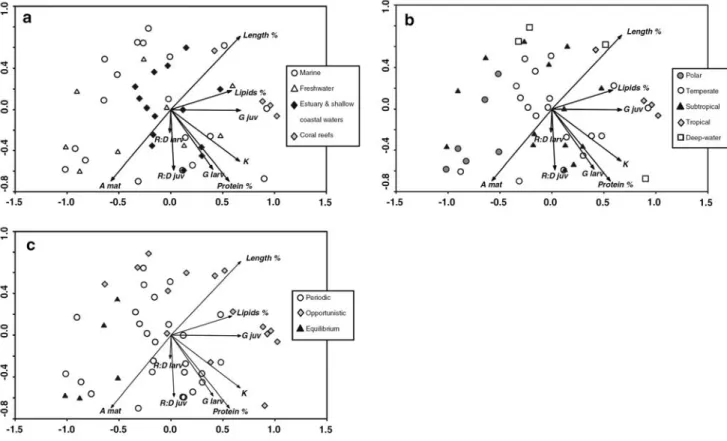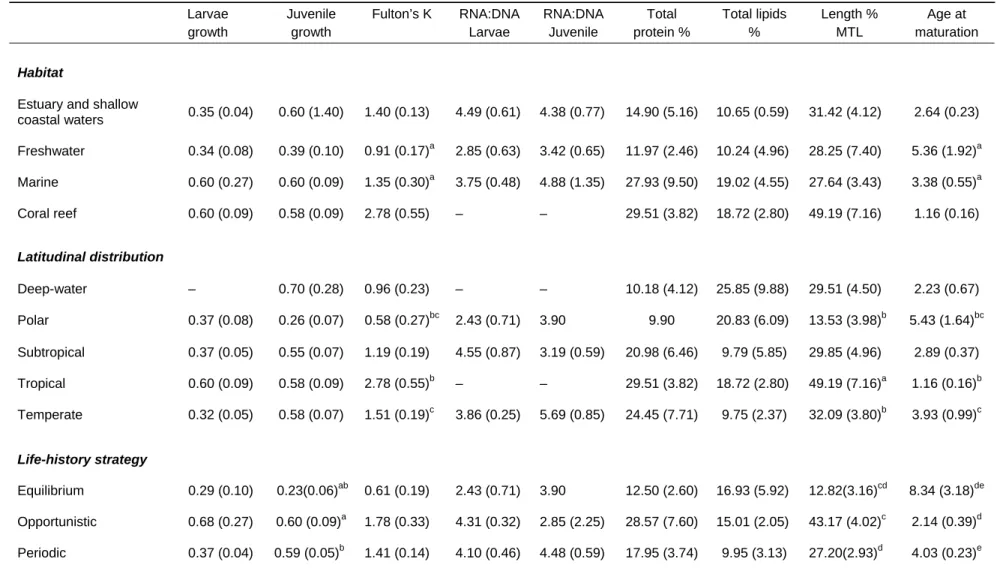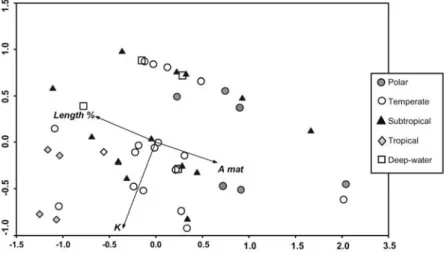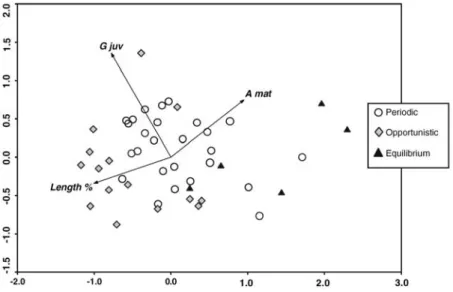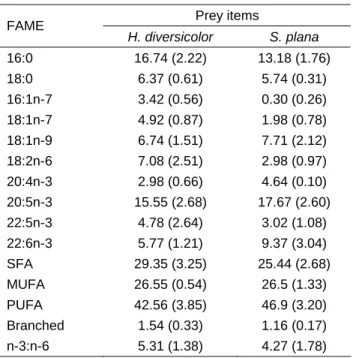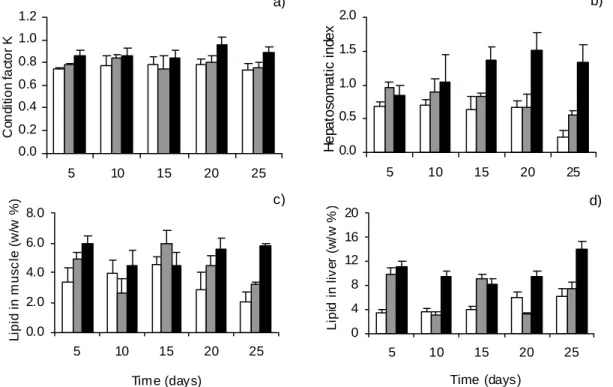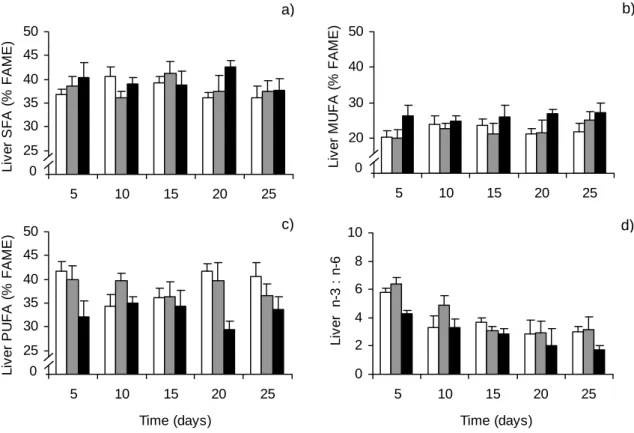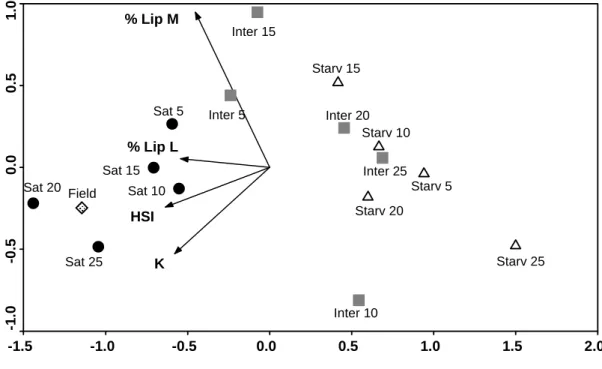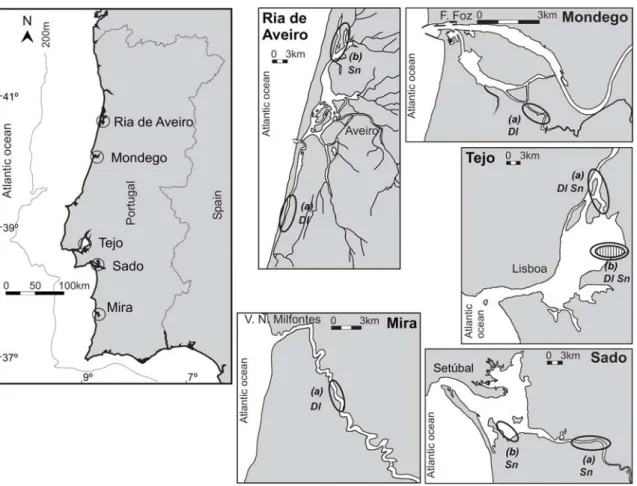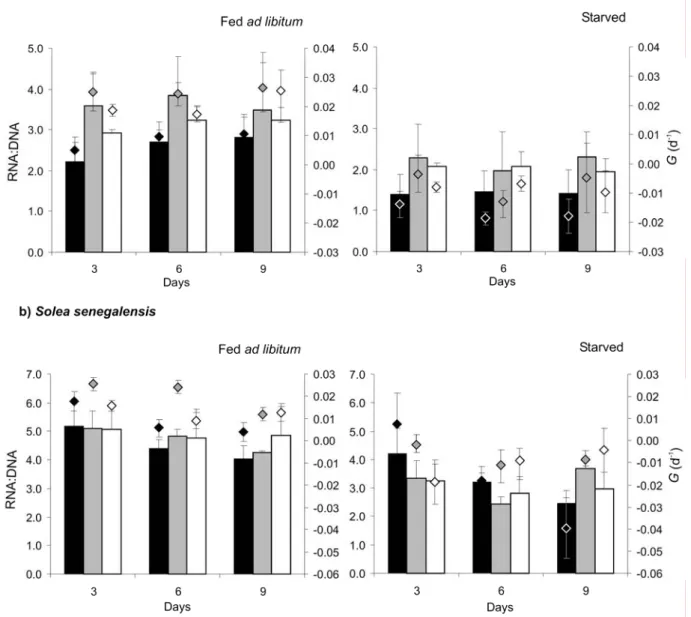Faculdade de Ci ncias
ê
Vanessa Filipa Sim o Fonseca
ã
Doutoramento em Biologia
Especialidade de Biologia Marinha e Aquacultura
2010
Fish physiological and biochemical responses
as indicators of habitat quality in estuarine systems
Faculdade de Ci ncias
ê
Vanessa Filipa Sim o
ã Fonseca
Doutoramento em Biologia
Especialidade de Biologia Marinha e Aquacultura
2010
Fish physiological and biochemical responses
as indicators of habitat quality in estuarine systems
Departamento de Biologia Animal
Tese orientada pelo
Doctoral dissertation in Biology
(specialization in Marine Biology and Aquaculture) presented to the University of Lisboa
Dissertação apresentada à Universidade de Lisboa para obtenção do grau de doutor
(especialidade Biologia Marinha e Aquacultura)
Vanessa Filipa Simão Fonseca
ABSTRACT AND KEYWORDS 7
RESUMO E PALAVRAS-CHAVE (PT) 9
RESUMO ALARGADO (PT) 11
LIST OF PAPERS 15
CHAPTER 1 17
General introduction 19
Aims and importance 21
Thesis outline 22
CHAPTER 2 27
Are fish early growth and condition patterns related to life-history
strategies?
CHAPTER 3 53
Lipid-based indicators of nutritional condition in juvenile sole Solea
solea
CHAPTER 4 69
Growth performance of juvenile Dicentrarchus labrax and Solea
senegalensis in estuaries along the Portuguese coast assessed via
experimental calibration
CHAPTER 5 87
Ecophys.Fish perspectives on growth of juvenile soles, Solea solea and
Solea senegalensis, in the Tagus estuary, Portugal
CHAPTER 6 105
Short-term variability of condition indices in fish from estuarine and shallow coastal areas of the Portuguese coast: response to environmental variability
CHAPTER 7 121
Effect of copper exposure on growth, condition indices and biomarker response in juvenile sole Solea senegalensis
CHAPTER 8 135
Short-term variability of multiple biomarker response in fish from estuaries: influence of environmental dynamics
CHAPTER 9 151
Multi-biomarker responses to estuarine habitat contamination in three fish species: Dicentrarchus labrax, Solea senegalensis and Pomatoschistus microps
CHAPTER 10 175
General discussion 177
Future perspectives 182
Abstract
Estuaries are highly productive systems with high natural variability and affected by various anthropogenic pressures. Considering this complexity, several physiological and biochemical responses of fish were evaluated as indicators of habitat quality in estuaries. Condition indices, growth estimates and biomarkers of exposure and of effects to contaminants in fish were used due to their ability to integrate habitat quality, life-history, inter-specific, temporal and spatial patterns. Global growth and condition patterns of several fish species (larvae and juveniles) were related with latitudinal distribution, habitat and life-history strategies. Morphometric indices (K and HSI) and lipid content were good indicators of fish nutritional condition. Juveniles growth rates in different species were used to assess habitat quality, using an RNA:DNA based model and an ecophysiological framework that considered the interactions of metabolism, bioenergetics and environmental variability. The relation between environmental variability and variation patterns of condition indices and biomarkers of exposure to contaminants was assessed on a temporal scale of days to weeks. Despite the relationship observed between temperature and biochemical condition indices, natural variability had no effects on biomarkers at this scale. On an experimental approach, the effects of copper exposure induced responses of biomarker of exposure and of effects, including condition indices. A specific and multi-metric approach revealed spatial differences related with strong species patterns and degree of environmental contamination. Despite the sensitivity of the biomarkers of exposure to and of effects of contaminants, habitat quality assessment should take natural variability into consideration due to its possible relation with some markers at different scales, and to its strong influence on growth and condition patterns of fish in estuarine environments.
Resumo
Os estuários são sistemas altamente produtivos, com elevada variabilidade natural, afectados por pressões antropogénicas. Perante esta complexidade, várias respostas fisiológicas e bioquímicas de peixes foram avaliadas como indicadores da qualidade do habitat estuarino. Índices de condição, medidas de crescimento e biomarcadores de exposição e de efeitos de contaminantes foram utilizadas como integradores da qualidade ambiental, tendo sido avaliados padrões de história de vida, inter-específicos, temporais e espaciais. Padrões globais de crescimento e condição de várias espécies de peixes (larvas e juvenis) foram relacionados com a distribuição latitudinal, habitat e estratégias de vida. Índices morfométricos (K e HSI) e conteúdo lipídico foram bons indicadores da condição nutricional de peixes. Taxas de crescimento de juvenis de diferentes espécies foram utilizadas na caracterização da qualidade do habitat, modeladas com recurso à razão ARN:ADN, e ainda com base num modelo ecofisiológico que relaciona o metabolismo, bioenergética e variabilidade ambiental. A relação da variabilidade ambiental com os padrões de variação de índices de condição e biomarcadores de exposição a contaminantes foi avaliada numa escala temporal de dias e semanas. Apesar da relação observada entre temperatura e índices bioquímicos de condição, não foram observados efeitos da variabilidade natural nos biomarcadores a esta escala. Numa abordagem experimental, os efeitos da exposição ao cobre induziram respostas ao nível de biomarcadores de exposição e de efeitos, nos quais se incluiram índices de condição. Uma abordagem multi-específica e multi-métrica revelou diferenças espaciais relacionadas com fortes padrões específicos e com os níveis de contaminação ambiental. Apesar da sensiblidade revelada pelos biomarcadores de exposição e de efeitos da contaminação, a variabilidade natural deve ser necessariamente considerada na avaliação da qualidade ambiental pela sua possível relação com alguns marcadores a diferentes escalas e pela sua marcada influência nos padrões de crescimento e condição de peixes em meio estuarino.
Palavras-chave: estuários; peixes; crescimento; índices de condição; biomarcadores;
Resumo alargado
Os estuários são ecossistemas caracterizados por uma elevada produtividade ecológica, marcados por extensos padrões de variabilidade natural a várias escalas temporais e sujeitos a inúmeras pressões antropogénicas.
O presente estudo tem como objectivo principal avaliar o potencial de respostas fisiológicas e bioquímicas em peixes como indicadores da qualidade do habitat em ambiente estuarino, integrando simultaneamente os stresses naturais e antropogénicos. Face à complexidade de processos e interacções abióticas e bióticas que caracterizam os estuários, a resposta a esta questão exige uma abordagem integrativa das suas várias dimensões, com recurso a diferentes ferramentas e metodologias que actuam a diferentes níveis de organização biológica.
A presente tese é composta por dez capítulos, dos quais oito referem-se a artigos científicos, publicados ou submetidos e em revisão em revistas internacionais com arbitragem científica indexadas no Science Citation Index. Os restantes capítulos referem-se ao capítulo inicial de introdução geral e ao capítulo final, onde são apresentadas a discussão geral e as considerações finais.
Na introdução geral, capítulo 1, foi realizado um enquadramento do tema da presente tese, no que concerne: a dicotomia variabilidade natural vs stress antropogénico presente nos estuários; a legislação actual que prevê o desenvolvimento de metodologias para avaliar a qualidade ambiental nestes sistemas; e a utilidade dos peixes e das suas respostas a nível sub-individual como indicadores da qualidade ambiental.
Uma revisão global explorando a forma como os padrões de crescimento e condição na fase larvar e juvenil estão relacionados com as estratégias de vida (segundo o modelo desenvolvido por Winemiller e Rose 1992), a utilização do habitat e a distribuição latitudinal das espécies de peixes é apresentada no capítulo 2. Na base desta comparação está uma ampla compilação de dados ecológicos relativos às fases larvar e juvenil de 46 espécies de peixes, nomeadamente percentagem do comprimento máximo alcançado no primeiro ano de vida, idade de maturação, factor de condição K (ou Fulton), razão ARN:ADN, conteúdo lipídico e conteúdo proteico. A análise multivariada permitiu uma segregação coerente das espécies de acordo com a distribuição geográfica e a utilização do habitat das mesmas, assim como a separação dos três tipos de estratégias de vida definidos pela metodologia utilizada. Assim, espécies de peixes que ocorrem em ambientes mais complexos e variáveis, como recifes de coral e estuários, apresentaram taxas de crescimento e índices de condição superiores comparativamente a espécies que ocorrem em ambientes mais estáveis ou previsíveis, como
os ambientes de água-doce ou regiões polares, que por sua vez apresentaram um desenvolvimento mais tardio e maiores reservas energéticas.
O valor de vários indicadores lipídicos de condição nutricional em peixes foi testado numa experiência laboratorial, discutida no capítulo 3. De acordo com o período experimental, os indicadores que mais fielmente retrataram os diferentes níveis de alimentação foram os morfométricos (factor de condição K e índice hepatosomático HSI) e o conteúdo em lípidos totais no fígado de juvenis de linguados (Solea solea). A análise de classes de ácidos gordos também evidenciou padrões interessantes, nomeadamente a preservação de ácidos gordos polinsaturados, muitos dos quais são essenciais para peixes. Quanto à análise de ácidos gordos individuais, não foi possível detectar padrões de variação consistentes com o stress nutricional, o que se atribui à influência do perfil em ácidos gordos da dieta e à complexidade de processos de incorporação, oxidação e síntese destas moléculas.
No capítulo 4 foi desenvolvido um modelo de estimação da taxa de crescimento em juvenis de robalo (Dicentrarchus labrax) e de linguado do Senegal (Solea senegalensis), por meio de uma calibração experimental da razão ARN:ADN face a diferentes temperaturas e salinidades. Os modelos desenvolvidos foram aplicados numa avaliação da qualidade do habitat para juvenis de ambas as espécies recolhidos em cinco estuários da costa Portuguesa, nos anos de 2005 e 2006. A estimativa da percentagem da taxa de crescimento individual (realizada por comparação com a taxa máxima ou de referência observada) permitiu avaliar as diferenças inter-estuarinas e inter-anuais para ambas as espécies relacionadas com a variabilidade ambiental.
Na sequência da estimativa de taxas de crescimento de peixes em ambiente estuarino, foi parametrizado e aplicado um modelo ecofisiológico, Ecophys.Fish (Neill et al. 2004), que integra os efeitos e interacções da variação abiótica no metabolismo e processos bioenergéticos em peixes (Capítulo 5). O crescimento é determinado com base na energia metabólica disponível depois de mobilizada a energia para actividades de rotina (processamento dos alimentos, excreção). As estimativas de crescimento obtidas reflectiram com um elevado grau de fidelidade os valores de estudos prévios utilizados para a parametrização inicial do modelo. A aplicação do modelo a uma série de dados de quatro anos para o estuário do Tejo revelou padrões de variação no crescimento de juvenis de linguados (S. solea e S. senegalensis) associados à variabilidade ambiental inter-anual.
No capítulo 6 foi explorada a relação entre variáveis abióticas (temperatura e salinidade) e a variação de índices de condição numa escala temporal de dias e semanas. Foram amostradas três espécies de peixes no estuário do Tejo (D. labrax, S. senegalensis e o caboz, Pomatoschistus microps) e uma na zona costeira adjacente (o carapau, Trachurus
trachurus), com o objectivo de comparar os padrões de condição de espécies em ambientes
com níveis contrastantes de variabilidade natural. Foram descritas correlações positivas entre a temperatura e os índices de condição bioquímicos (razão ARN:ADN e conteúdo proteico). No entanto, nenhuma relação foi estabelecida com a salinidade. Também não foram observadas diferenças nos padrões de condição entre as espécies de habitats contrastantes, o que
certamente se deve à capacidade de resiliência das espécies estuarinas face à elevada variabilidade ambiental previamente descrita.
Na abordagem experimental descrita no capítulo 7 comparam-se várias respostas de exposição e de efeitos do cobre em juvenis de S. senegalensis. Neste caso, um conjunto de índices de condição foram considerados também como respostas de efeitos. Vários biomarcadores assinalaram a exposição ao cobre, nomeadamente a indução significativa de metalotioninas (MT), o aumento da peroxidação lipídica e a redução significativa da razão ARN:ADN. A taxa de crescimento de peixes sujeitos a contaminação manteve-se positiva, apesar de inferior ao grupo de controle, o que foi associado à mobilização das reservas lipídicas.
Os efeitos da variabilidade ambiental foram novamente investigados no capítulo 8. Foi realizada uma avaliação da variação diária e semanal de um conjunto de biomarcadores de exposição a contaminantes em três espécies de peixes no estuário do Tejo (D. labrax, S.
senegalensis e P. microps) considerando a variação concomitante da temperatura e salinidade.
A actividade das enzimas antioxidantes (catalase, CAT; e superoxide dismutase, SOD) apresentou menor variabilidade temporal que a actividade das enzimas de biotransformação (glutationa S-transferase, GST; e 7-Etoxiresorufina O-desetilase, EROD). Contudo, à excepção da correlação positiva entre a temperatura e a actividade da CAT em juvenis de S.
senegalensis, não foram estabelecidas outras relações entre as variáveis ambientais e os
biomarcadores. A maior especificidade das enzimas de biotransformação face à exposição a contaminantes foi corroborada pelas respostas concordantes de EROD e GST.
No capítulo 9 foi avaliada a qualidade ambiental de habitats estuarinos com uma abordagem integradora dos capítulos anteriores: multi-específica (D. labrax, S. senegalensis e
P.microps), multi-métrica [enzimas antioxidantes (SOD, CAT, glutationa peroxidase total
(TGPx) e selénio-dependente (SeGPx); enzimas de biotransformação (GST, EROD); metalotioninas (MT); nível de peroxidação lipídica (LPO); razão ARN:ADN; conteúdo proteico e lipídico] e com medidas da contaminação ambiental [concentração de metais e hidrocarbonetos aromáticos policíclicos (PAH) no sedimento]. Várias fontes de pressão antropogénica foram identificadas com base nos níveis de contaminação do sedimento em três locais do estuário do Tejo e da Ria de Aveiro. As diferenças inter-específicas nas respostas biológicas sobrevieram aos padrões de variação espacial, sublinhando a importância das diferenças ecológicas entre espécies e da qualidade de habitat relativa para cada espécie. Não obstante, locais com maior nível de contaminação e toxicidade foram associados a uma indução significativa de respostas de biomarcadores antioxidantes e de biotransformação, bem como a uma redução da condição dos peixes amostrados nestas áreas.
Por último, no capítulo 10 é realizada uma discussão geral, onde são integrados os principais resultados e conclusões dos capítulos anteriores e delineadas perspectivas futuras de investigação, no contexto do objectivo geral do estudo de associar as respostas fisiológicas e bioquímicas de peixes à qualidade ambiental, integrando a variabilidade natural e as pressões antropogénicas.
L
IST OF PAPERSThis thesis is comprised by the papers listed below, each corresponding to a Chapter, from 2 to 9. The author of the thesis was responsible for conception and design of the work, field surveys, sample collection and processing, laboratory analytical procedures, data analysis and manuscript writing of all the papers. Remaining authors collaborated in some or several of these procedures. All papers published or in press were included with the publishers’ agreement.
CHAPTER 2: Are fish early growth and condition patterns related to life-history strategies?
Vanessa Fonseca, Henrique N Cabral
Published in Reviews in Fish Biology and Fisheries (2007) 374(2-3):199-215 DOI 10.1007/s11160-007-9054-x
CHAPTER 3: Lipid-based indicators of nutritional condition in juvenile sole Solea solea
Vanessa Fonseca, Luís Narciso, Henrique N Cabral In review in Journal of Applied Icthyology
CHAPTER 4: Growth performance of juvenile Dicentrarchus labrax and Solea senegalensis in
estuaries along the Portuguese coast assessed via experimental calibration
Vanessa Fonseca, Rita P Vasconcelos, Patrick Reis-Santos, Susanne Tanner, Henrique Cabral In review in Journal of Fish Biology
CHAPTER 5: Ecophys.Fish perspectives on growth of juvenile soles, Solea solea and Solea
senegalensis, in the Tagus estuary, Portugal
Vanessa Fonseca, William H Neill, John M Miller, Henrique N Cabral Published in Journal of Sea Research (2010) 64(1-2):118-124 DOI: 10.1016/j.seares.2009.10.007
CHAPTER 6: Short-term variability of condition indices in fish from estuarine and shallow coastal
areas of the Portuguese coast: response to environmental variability
Vanessa Fonseca, Rita P Vasconcelos, Susana França, Marisa Batista, Susanne Tanner, Henrique Cabral
In review in Estuarine, Coastal and Shelf Science
juvenile sole Solea senegalensis
Vanessa Fonseca, Ângela Serafim, Rui Company, Maria João Bebianno, Henrique Cabral Published in Scientia Marina (2009) 73(1): 51-58
DOI: 10.3989/scimar.2009.73n1051
CHAPTER 8: Short-term variability of multiple biomarker response in fish from estuaries:
influence of environmental dynamics
Vanessa Fonseca, Susana França, Rita P Vasconcelos, Ângela Serafim, Ruy Company, Belisandra Lopes, Maria João Bebianno, Henrique N Cabral
In review in Aquatic Toxicology
CHAPTER 9: Multi-biomarker responses to estuarine habitat contamination in three fish species:
Dicentrarchus labrax, Solea senegalensis and Pomatoschistus microps
Vanessa Fonseca, Susana França, Ângela Serafim, Rui Company, Belisandra Lopes, Maria João Bebianno, Henrique N Cabral
C
HAPTER
1
General introduction
Aims and importance
Thesis outline
General introduction
Aims and importance
Thesis outline
General introduction
Estuaries are highly productive ecosystems that sustain valuable biological and economic resources (Costanza et al. 1997; McLusky and Elliott 2004). These transitional environments support fundamental ecological links between freshwater and marine environments, with a diverse fish assemblage of resident, occasional, early-life stage and migratory organisms (Beck et al. 2001; Able 2005; Franco et al. 2008). From a functional perspective, estuaries are particularly important for fish as they provide various habitats for feeding, refuge from predators, nursery areas, reproduction and migration routes for species that are resilient to the highly dynamic environment (Haedrich 1983; McLusky and Elliott 2004; Elliott et al. 2007). Estuarine systems are characterized by highly dynamic environmental conditions, such as varying water temperature, salinity and dissolved oxygen concentration, chiefly due to the influence of tidal regimes, freshwater input and seawater intrusion. Hence, estuaries are widely regarded as naturally stressful environments, where only species that can accommodate or adapt to the inherently dynamic conditions can thrive (McLusky and Elliott 2004, 2007).
In addition to natural variability, estuaries are also impacted by multiple anthropogenic stressors, derived from the intense human activities and interests typically established in these areas, including domestic, agricultural and industrial effluent discharges, port activities, bank reclamation, dams and fishing (Kennish 2002; Vasconcelos et al. 2007; Dauvin 2008). Accordingly, increased awareness of the potential risks posed by the permanent pressures and overexploitation of these ecosystems resources led to integrated legislative protective action worldwide. These include the European Union (EU) Water Framework Directive (WFD, 2000/60/EC) and the EU Marine Strategy Framework Directive (MSFD, 2008/56/EC), the National Land and Water Resources Audit in Australia (Heap et al. 2001), the Clean Water Act in the United States of America (USEPA 2002) and the Water Act in South Africa (Adams et al. 2002), all aiming at the sustainable and integrated management of water resources.
In general terms, the EU Water Framework Directive aims at: preventing further deterioration of water resources; enhancing protection and improvement of the aquatic environment (e.g. through the reduction of discharges and pollution levels); and mitigating the effects of floods and droughts. According to the WFD all EU member states are required to assess the ecological quality status of their rivers, lakes, groundwater, transitional and coastal waters, and achieve a good ecological status in all water bodies by 2015 (WFD, 2000/60/EC). In
this context the definition of good ecological status refers to low levels of distortion on the biological quality elements resulting from anthropogenic activity, when compared to undisturbed reference conditions. Applying this definition to fish, renders that a habitat of good quality for fish is associated with an assemblage with high densities, high species richness, presence of species sensitive to disturbance and suitable conditions for growth, survival and reproduction, taking into account the habitat reference conditions.
Fish, and their responses, have been extensively used as indicators of habitat quality in assessment tools developed for scientific and management purposes (e.g. Deegan et al. 1997; Delpech et al. 2010). The value of fish as biological quality elements relies on some key features: i) their wide dispersion in the aquatic environment and diversity of functional guilds, which covers the spectrum of anthropogenic stressors; ii) their major ecological role in food-webs, carrying energy from lower to higher trophic levels; iii) their relatively long life-span, which accounts for long-term effects of stressors on a biological endpoint; iv) they are a direct resource for men, which heightens the level of public conscious relative to conservation needs and cost-benefit analysis (Whitfield and Elliott 2002, van der Oost et al. 2003).
Earlier approaches to habitat quality assessment for fish looked into species presence or absence data, abundance, production, growth and survival, whenever data was available (e.g. Karr 1981; Rogers 1992; Able et al. 1999). All these descriptors have a significant ecological meaning, ranging from the individual to the community level. However, increasing levels of biological organization are more difficult to relate to specific anthropogenic pressures (Adams 2002). As a consequence, biological responses at the sub-organism level that exhibit faster response time and higher specificity or known mechanistic responses to particular stressors have become a rapid emerging topic, with new techniques and biochemical processes being applied to assess environmental disturbance (Adams 2002, van der Oost et al. 2003).
Biomarkers are generally defined as measures of change in biological responses, at the sub-individual level (e.g. molecular, physiological), linked to a potential anthropogenic hazard, which may be physical, chemical or biological (see review in van der Oost et al. 2003). These can be classified into biomarkers of exposure and biomarkers of effects (some authors also consider biomarkers of susceptibility, which are beyond the scope of this thesis). Biomarkers of exposure refer to biological responses that enable the detection of xenobiotics; while biomarkers of effects include biochemical, physiological or other sub-organism biological changes that can be linked to a stress or health impairment, and thus can also serve as biomarkers of exposure (van der Oost et al., 2003). A wide range of biochemical and physiological measures have been extensively used has biomarkers, such as the activity level of antioxidant enzymes, biotransformation enzymes, metallothioneins which are usually considered biomarkers of exposure; whilst the level of molecular oxidative damage (e.g. lipid peroxidation) and even measures of condition and general health can be used as biomarkers of effects.
Establishing direct relationships between biomarkers of exposure to pollutants and additional ecological consequences at the individual or higher biological level represents a
difficult challenge, one which still demands for further research into individual adaptability and the influence of natural environmental conditions (Adams 2002; van der Oost et al. 2003). Hence, it is important to understand how exposure biomarker responses to contamination interact with fish growth and condition, and to assess potential deleterious effects at such relevant endpoints. In addition, fish growth and condition indices have been extensively used as measures of habitat quality, since they are integrative measures of the whole environment (Phelan et al. 2000; Lloret and Planes 2003; Fonseca et al. 2006; Amara et al. 2007; Vasconcelos et al. 2009). Growth and condition indices integrate environmental variability and allow for an assessment of fish health in a given habitat, by considering how fish respond to abiotic and biotic variables, food quality and availability and also pollution. The utility of assessing fish health and condition in a habitat quality assessment context is accentuated by the difficulty to discriminate between the effects of natural variability and anthropogenic induced stress, which has been recently described as the Estuarine Quality Paradox (Dauvin 2007; Elliott and Quintino 2007). Accordingly, Elliott and Quintino (2007) pointed out that to overcome this issue, it would be necessary to quantify the effects of natural stress and subtract this from the anthropogenic stress, or to use alternative methods to detect anthropogenic stress against a background of natural stress.
Aims and importance
The aim of the present thesis was to investigate the use of fish physiological and biochemical responses as indicators of habitat quality in the estuarine environment.
Highly dynamic environmental settings allied with significant anthropogenic stressors present in estuaries provide a complex context for the assessment of estuarine habitat quality for fish. Therefore, different yet complementary approaches were used to resolve various aspects of this issue, i.e. effects of natural variability, effects of contaminants, realistic temporal scales, selection of adequate biomarkers, confounding factors in biomarker analysis, multi-species differences in biochemical and physiological responses. These several dimensions were addressed with laboratory calibration experiments, models application, field assessments and multi-species and multi-biomarkers approaches.
In view of the present thesis context, good habitat quality is associated with favorable conditions for fish growth, low energy expenditure and high metabolic scope for fish activities (e.g. growth, reproduction) as well as low pollution levels that do not elevate biochemical defense and detoxification mechanisms above baseline values.
The value of this study relies on its multiple approaches and methodologies, which allow for a real and ecologically meaningful framework of habitat quality assessment for fish. The expected results include the ability to assess growth and fish condition in time-varying scenarios, the selection of adequate biomarkers and species to evaluate habitat quality in different contexts, and the identification of major confounding factors in biomarker analysis considering these factors variation in a significant time scale.
condition, growth and overall fish health, and hence of habitat quality for fish. These indices can be viewed as integrative of the whole environment, including chemical exposure. Since exposure to contaminants can have deleterious effects on fish health, condition indices were also tested in this study as biomarkers of effects in both experimental and field assessments. This represents an innovative perspective, seldom explored in current research studies.
Overall, the core idea was to go beyond physical-chemical characterization and species numerical assessment of habitat quality, by exploring physiological and biochemical endpoints. These biological endpoints, with higher pressure specificity and early response time, can signal stressors and account for early and reversible biological effects taking into account the natural variability in estuarine conditions.
Ultimately, understanding how fish first respond and integrate environmental quality in an estuarine environment is of the utmost importance for the evaluation of habitat quality and the protection of this economical and ecologically important resource, in view of present and future legislative and management perspectives.
Thesis outline
The present thesis comprises eight scientific papers published or in review in peer reviewed international journals, each corresponding to a chapter.
A review of how fish early growth and condition patterns are related to life-history strategies is discussed in Chapter 2. A broad comparison of early-life features in forty-six fish species, specifically first year length percentage, age at maturation, condition factor K (Fulton), RNA:DNA ratio, and lipid and protein content, was used to evaluate degree of species segregation related with latitudinal distribution, habitat use patterns and life-history strategies [based on the framework developed by Winemiller and Rose (1992)].
In Chapter 3 the dynamics of fish lipid content, including measures at the individual and molecular level, is evaluated through a laboratory experiment. A set of lipid-based indices of condition, from morphometric indices (condition factor K and hepatosomatic index) to individual fatty acid percentages, are evaluated as potential indicators of feeding level.
Further experimental calibration is described in Chapter 4, as a means to estimate juvenile fish growth in estuaries. Growth rate estimates and growth performance based on a nucleic acid model were determined for two marine migrant fish species in five systems along the Portuguese coast during two consecutive years. Overall, habitat quality for both species was analysed based on juveniles’ growth performance.
In Chapter 5, estuarine environmental dynamics, fish metabolism and bioenergetics are integrated into a mechanistic model developed to simulate fish growth in time-varying environments, the Ecophys.Fish (Neill et al. 2004). This ecophysiological framework was parameterized for two sole species, and applied to a four year data series for the Tejo estuary, in order to characterize habitat quality based on juveniles metabolic scope for growth and estimated growth rates.
in four fish species inhabiting estuarine and shallow coastal areas, was explored in Chapter 6. Variation of condition indices was measured on a scale of consecutive days to weeks, and related to the variation of water temperature and salinity on a concordant time scale. The potential differences in fish condition indices due to the contrasting environments were also discussed.
In Chapter 7 a wide array of biomarkers of exposure to and effects of contaminants were tested in an experimental setting, designed to observe the combined responses of these biomarkers to chemical stress (copper contamination). Fish biomarker responses included lipid peroxidation, morphometric and biochemical condition indices as measures of biological effects, whilst metallothioneins were used as specific biomarkers of exposure to metal toxicity.
The effects of short-term temporal variability of environmental conditions on biomarkers of exposure were determined on Chapter 8. A set of adaptation responses, with different degrees of specificity to contaminants, were determined in three fish species, sampled on estuarine sites on a daily and weekly scale, and the relation with abiotic variables (temperature and salinity) assessed.
In Chapter 9 an integrated multi-biomarker and multi-specific approach was applied to assess habitat quality in two estuarine systems, integrating previously applied metrics and results. Habitat chemical characterization, measured in the form of metals and polycyclic aromatic hydrocarbons concentration, was used as covariate in the analysis on the spatial variability patterns in fish biomarker responses. Species specific differences in biomarker responses were also discussed in terms of life-history traits and habitat use.
A general discussion of the major results from these studies is presented in the final Chapter 10. In this chapter, an integrative view of the main conclusions is presented within the context of the use of fish as indicators of habitat quality, particularly in estuarine systems, as well as future research perspectives.
Literature cited
Able KW (2005) A re-examination of fish estuarine dependence: Evidence for connectivity between estuarine and ocean habitats. Est Coast Shelf Sci 64(1):5-17.
Able KW, Manderson, JP, Studholme, AL (1999) Habitat quality for shallow water fishes in an urban estuary: the effects of man-made structures on growth. Mar Ecol Prog Ser 187:227-235.
Adams JB, Bate GC, Harrison TD, Huizinga P, Taljaard S, van Niekerk L, Plumstead EE, Whitfield AK, Wooldridge TH Adams, JB; Bate, GC; Harrison, TD (2002) A method to assess the freshwater inflow requirements of estuaries and application to the Mtata estuary, South Africa. Estuaries 25(6B):1382-1393.
Adams SM (2002) Biological Indicators of Aquatic Ecosystem Stress: Introduction and Overview. In: Adams SM (ed) Biological indicators of aquatic ecosystem stress, American Fisheries Society, Bethesda, Maryland, USA, pp 1-11.
Amara R, Meziane T, Gilliers C, Hermel G, Laffargue P (2007) Growth and condition indices in juvenile sole Solea solea measured to assess the quality of essential fish habitat. Mar Ecol Prog Ser 351:201-208.
K, Minello TJ, Orth RJ, Sheridan PF, Weinstein MR (2001) The identification, conservation and management of estuarine and marine nurseries for fish and invertebrates. BioScience 51(8):633-641. Costanza R, dArge R, deGroot R, Farber S, Grasso M, Hannon B, Limburg K, Naeem S, ONeill RV,
Paruelo J, Raskin RG, Sutton P, van den Belt M (1997) The value of the world's ecosystem services and natural capital. Nature 387(6630):253-260.
Dauvin JC (2007) Paradox of estuarine quality: Benthic indicators and indices, consensus or debate for the future. Mar Pollut Bull 55(1-6):271 281.
Dauvin JC (2008) The main characteristics, problems, and prospects for Western European coastal seas. Mar Pollut Bull 57(1-5):22-40.
Deegan LA, Finn JT, Buonaccorsi J (1997) Development and validation of an estuarine biotic integrity index. Estuaries 20 (3):601-617.
Delpech C, Courrat A, Pasquaud S, Lobry J, Le Pape O, Nicolas D, Boet P, Girardin M, Lepage M (2010) Development of a fish-based index to assess the ecological quality of transitional waters: The case of French estuaries. Mar Pollut Bull 60(6):908-918.
Elliott M, Quintino V (2007) The estuarine quality paradox, environmental homeostasis and the difficulty of detecting anthropogenic stress in naturally stressed areas. Mar Pollut Bull 54(6): 640-645.
Elliott M, Whitfield AK, Potter IC, Blaber SJM, Cyrus DP, Nordlie FG, Harrison TD (2007) The guild approach to categorizing estuarine fish assemblages: a global review. FISH AND FISHERIES 8 (3): 241-268.
Fonseca VF, Vinagre C, Cabral HN (2006) Growth variability of juvenile soles Solea solea and Solea
senegalensis, and comparison with RNA:DNA ratios in the Tagus estuary, Portugal. J Fish Biol
68(5):1551-1562.
Franco A, Elliott M, Franzoi P, Torricelli P (2008) Life strategies of fishes in European estuaries: the functional guild approach. Mar Ecol Prog Ser 354:219-228.
Haedrich RL (1983) Estuarine fishes. In Ketchum BH (ed) Ecosystems of the World, Book 26. Estuaries and enclosed seas. Elsevier, Amsterdam, Netherlands, p 183-207
Heap A, Bryce S, Ryan D, Radke L, Smith C, Smith R, Harris P, Heggie D (2001) Australian estuaries and coastal waterways: a geoscience perspective for improved and integrated resource management. A Report to the National Land & Water Resources Audit. Theme 7: Ecosystem Health, Australian Geological Survey Organisation, Record 2001/07, pp 118.
Karr JR (1981) Assessment of biotic integrity using fish communities. Fisheries 6(6):21-27.
Kennish MJ (2002) Environmental threats and environmental future of estuaries. Environ Conserv 29(1):78-107
Lloret, J. and Planes, S. (2003) Condition, feeding and reproductive potential of white seabream Diplodus
sargus as indicators of habitat quality and the effect of reserve protection in the Northwestern
Mediterranean. Mar Ecol Prog Ser 248:197–208.
McLusky DS, Elliott M (2004) The estuarine ecosystem: ecology, threats and management. 3rd ed, Oxford University Press, 214 p.
McLusky DS, Elliott M (2007) Transitional waters: A new approach, semantics or just muddying the waters? Estuar Coast Shelf Sci 71(3-4):359-363.
MSFD (2008) Directive 2008/56/EC of the European Parliament and of the Council of 17 June 2008, establishing a framework for the Community action in the field of marine environmental policy (Marine Strategy Framework Directive). Official Journal of the European Union, L 164, 25/6/2008.
Phelan BA, Goldberg R, Bejda AJ, Pereira J, Hagan S, Clark P, Studholme AL, Calabrese A, Able KW (2000) Estuarine and habitat-related differences in growth rates of young-of-the-year winter flounder
(Pseudopleuronectes americanus) and tautog (Tautoga onitis) in three northeastern US estuaries. J Exp Mar Biol Ecol 247(1):1-28.
Rogers SI (1992) Environmental factors affecting the distribution of sole (Solea solea (L.) within a nursery area. Neth J Sea Res 29(1-3):153-161.
USEPA (2002) National Water Quality Inventory 2000 Report, USA National Environmental Protection Agency.
van der Oost R, Beyer J, Vermeulen NPE (2003) Fish bioaccumulation and biomarkers in environmental risk assessment: a review. Environ Toxicol Pharmacol 13(2):57-149
Vasconcelos RP, Reis-Santos P, Fonseca V, Maia A, Ruano M, França S, Vinagre C, Costa MJ, Cabral HN (2007) Assessing anthropogenic pressures on estuarine fish nurseries along the Portuguese coast: A multi-metric index and conceptual approach. Sci Total Environ 374(2-3):199-215.
Vasconcelos RP, Reis-Santos P, Fonseca V, Ruano M, Tanner S, Costa MJ, Cabral HN (2009) Juvenile fish condition in estuarine nurseries along the Portuguese coast. Estuar Coast Shelf Sci 82(1):128-138.
WFD (2000) Directive 2000/60/EC of the European Parliament and of the Council of October 23 2000, establishing a framework for the Community action in the field of water policy (Water Framework Directive). Official Journal of the European Union, L 327, 22/12/2000.
Whitfield AK, Elliott M (2002) Fishes as indicators of environmental and ecological changes within estuaries: a review of progress and some suggestions for the future. J Fish Biol 61(SupplA):229-250. Winemiller KO, Rose KA (1992) Patterns of life-history diversification in North American fishes:
C
HAPTER
2
A
re fish early growth and condition patterns related to life-history strategies?Vanessa Fonsecaa, Henrique N Cabrala,b
a
Instituto de Oceanografia, Faculdade de Ciências da Universidade de Lisboa, Campo Grande, 1749-016 Lisboa, Portugal
b
Departamento de Biologia Animal, Faculdade de Ciências da Universidade de Lisboa, Campo Grande, 1749-016 Lisboa, Portugal
Reviews in Fish Biology and Fisheries (2007) 374(2-3):199-215 DOI 10.1007/s11160-007-9054-x
A
re fish early growth and condition patterns
related to life-history strategies?
Abstract: Life-history studies provide a global framework for comparison of fish species
responses and trade-offs facing ecological and environmental constrains. A broad comparison among fishes’ early growth and condition traits is performed in order to determine ecological patterns of early development regarding latitudinal distribution, habitat use and life-history strategies. Based on Winemiller and Rose (1992) classification of life-history strategies, data on early growth and condition indices of 46 fish species worldwide was analysed. Available information on fishes’ early features, namely first year length percentage (relative to species maximum theoretical length), age at maturation and Fulton’s condition index (K), provided a good segregation of species by latitudinal distribution and habitat use, and evidenced the categories of the three-endpoint model. Higher larvae and juvenile growth rates and condition indices (K, mean RNA–DNA ratios and protein contents) were associated with tropical and temperate fish species that occur in complex or variable habitats (respectively coral reefs and estuaries). These species selected for the opportunistic and periodic strategies, investing highly in rapid growth in order to increase survival probability to counter high mortality rates during early stages or unstable habitat conditions. Later age at maturation, slower larvae and juvenile growth as well as lower mean condition indices were consistent with fish species from more stable or predictable environments, as polar regions and freshwater habitats, which selected for the equilibrium strategy. Nonetheless, differences in energy allocation strategies during early stages were not observed, evidencing the scarcity of available data regarding condition indices and/or the importance of integrating life-history intermediate strategies. Future research into condition indices and other physiological processes, for a broader set of species and for a wider latitudinal and habitat range including seasonal variability (particularly for species from tropical and polar regions), is essential to better understand or test current theories of species ecological patterns. The use of direct quantitative measures of young fishes’ metabolic investment and fitness constitutes a new approach for life history studies, and should be fundamental for predicting species’ responses to acute environmental or human constrains, especially in a global climate change scenario that is expected to affect distribution and abundance of fish species worldwide.
Key-words: fish; early growth; condition; life history strategy
1. Introduction
Life-history traits and strategies of organisms have long faced natural selection, and the comparative study of patterns emerging from their evolution is the goal of life-history theory (e.g. Stearns 1976, 1992; Roff 1992). Life-history studies also examine how traits are intercorrelated and constrained by ecological factors and constitute an important tool to predict demographic responses to disturbances at variable spatial and temporal scales (Winemiller 2005). The different environmental conditions and habitats colonized by fish species sustain a certain degree of phenotypic plasticity within life-history patterns (Stearns 1989). However, not all strategies are expected to be maintained throughout consecutive generations, and an evolutionary convergence is believed to occur among phylogenetically close-related species and even between distributional areas (Vila-Gispert et al. 2002).
Fishes’ response to environmental and ecological constrains is complex, depending on the intricate relations between environmental conditions and the individual ability to adapt. Fish exhibit various adaptations or strategies that result from trade-offs among growth, reproduction and survival (Arendt 1997). For example delaying the age at maturation allocates more energy for juvenile growth (Rochet 2000); and assuming higher predation risks under suitable growth conditions, can also maximize growth rates with the payoff of better overcoming size dependent overwinter mortality (Schindler 1999).
Following Winemiller and Rose classification (1992) three life-history strategies of fish species can be identified as the endpoints of a trilateral continuum based on trade-offs among fish survival, fecundity and age at maturation. The opportunistic strategy maximizes the intrinsic rate of population growth through a reduction in mean generation time. This strategy is characterized by small-sized individuals with early maturation, that continuously release small eggs in order to colonize highly disturbed or constantly changing habitats. The periodic strategy concerns highly fecund fishes with some degree of delayed maturation that can exploit predictable spatial and temporal environmental patterns, in which habitat conditions are more suitable for growth and survival of the massive number of offspring produced. The equilibrium strategy comprises small to medium sized fish with delayed maturation that produce small clutches of large eggs and that present well developed parental care (Winemiller and Rose 1992). This model’s assumptions regarding fish early-life stages are that equilibrium strategists have higher juvenile survival, while periodic and opportunistic strategists have higher larval and juvenile growth rates.
Given the importance of early-life stages in population dynamics (May 1974), such that even small differences in early growth and survival rates can affect the number of recruits entering the adult stock (e.g. Houde 1987, 1989), and the high energetic costs associated with high development or growth rates (Kamler 1992), fishes’ strategies during early development are crucial for species success. Mortality rates at early stages are generally high and related to size-dependent factors, namely starvation and predation pressures (Miller et al. 1988; Kamler 1992; Houde 1994). Thus survival probability in early-life stages should increase with rapid growth, since larger fish have higher food consumption rates and lower vulnerability to predators when compared to smaller individuals (e.g. Peterson and Wroblewski 1984; Miller et al. 1988; Hoey and McCormick 2004). Larvae and juvenile fish in better condition are also presumably less likely to die of starvation or predation, since nutritional standing and energy storage act as buffers against environmental variability (Kerrigam 1996; van Dijk et al. 2005). Several measures of growth and condition of larvae and juvenile fish have been used to assess individual and population status as well as habitat quality (e.g. Buckley et al. 1999; Yamashita et al. 2003; Gilliers et al. 2004; Fonseca et al. 2006). These measures comprise growth indices (RNA:DNA ratios, protein specific growth rate, otolith increments), morphometric indices (Fulton’s K) and storage indices (lipid content) that relate to the individual ability to respond and interact with the environment at different time scales (Suthers 1998).
considering their responses to environmental variation, our goal is to determine ecological patterns of fish species during their early development regarding latitudinal distribution, habitat use and life-history strategies using Winemiller and Rose (1992) classification. Even though a latitudinal gradient in species metabolic pace is expected due to the regulatory effect of temperature, phylogenetic, ecological and habitat constraints should also affect species responses.
Therefore, the Winemiller and Rose model (W&R model) is analysed, particularly the early development strategies, in a new perspective for life-history studies, based on early-life growth and condition data by considering direct quantitative measures of young fishes’ metabolic investment and fitness. It is also hypothesised, based on the W&R model, that fish inhabiting more stable environments and that favour young fish survival can potentially allocate more energy for storage than fishes facing more variable environments and that invest on rapid growth. Thus there should be a difference between growth related indices and energy storage indices when considering different life-history strategies.
2. Materials and methods
2.1 Ecological and life-history dataset
Data on ecological and life-history traits were collected from literature sources for 46 fish species or genus worldwide (see Appendix). Fish early-life stages were characterized by larvae and juvenile growth (mm day–1); length percentage at the end of the first year relative to the species maximum theoretical length (MTL); age at maturation (years); Fulton’s condition index (K); RNA:DNA ratio for larvae and juvenile fish; and lipid and protein body content (% dry-weight).
Three major categorical descriptions were considered for species ordination purposes: (i) latitudinal distribution defined by climatic regions (polar, temperate, subtropical, tropical, and deepwater species); (ii) juvenile fish habitat (estuarine and shallow coastal waters, freshwater, marine, and coral-reef species); (iii) and life-history strategies based on the three-endpoint model by Winemiller and Rose (1992) (opportunistic, periodic and equilibrium strategists). Briefly, for the latter classification: equilibrium strategists present higher values of juvenile survival and delayed maturation, periodic strategists relate both to high fecundity and age at maturation, while the opportunistic strategists are characterized by low fecundity, low juvenile survival and early maturation. Each species strategy was considered as a weighed collection of five life-history traits that accounted for a good distinction of species strategies in previous work: parental care; egg size; number or spawning bouts per year; clutch size and length at maturation (Winemiller and Rose 1992). These five variables were considered of equal importance, as well as their degrees of variation concerning information on species life-history traits (e.g. degree of parental care as offspring placement or nest protection and care by parents; for further detail see Winemiller and Rose 1992). Larvae and juvenile growth as well as age at maturation were excluded from this classification in order to avoid redundant information in the analysis that evaluates the relationship between species’ strategies and significant early
life-history traits. Thus, our assumption was that if the model provides a good prediction, then the species ordination should evidence the different life-history strategies, habitat distribution and habitat use, associated with early-life features. The choice of species was limited by data availability and to coherent determinations of early growth and condition variables among species and studies. Despite variability in protocols mainly for condition measures, only similar and thus comparable data was used, taking into account several important factors: fish development stage, environmental or experimental conditions characteristic of each species natural environment, sample type and size and equal measurement units or ratios. In the present work, measures of condition are not used for assessment of species in better condition, since no direct comparisons of indices’ values are intended or interpreted as so. Instead, they are viewed as measures of metabolic activity and energy storage that result from fishes’ tactics facing specific environmental and ecological constraints. Values selected for condition indices were those characterized as indicators of good health or condition for each species by the respective authors, so that all species were equitably compared and appropriate for the study’s goal.
2.2 Statistical analysis
A principal components analysis (PCA) was performed on ln-transformed fish data in order to identify patterns of association among species and early-life traits according to habitat type, latitudinal distribution and life-history strategies. For each category (e.g. marine habitat, temperate region, equilibrium strategy) of fish guilds the mean value of the nine early-life variables was determined. These categories were then compared using non-parametric Kruskal–Wallis tests followed by a posteriori multiple comparisons (Zar 1996), since the data set failed to meet the assumptions of parametric tests, even after transformation. The differences between categories would not account for the total variability of the data set; nonetheless given the limitations of the available data these differences might explain a great part of the species aggregation patterns. The significant variables per fish guild (i.e. variables which best describe the variability of the data from the latitudinal distribution, habitat use and life history strategies) were then analysed separately in three new ordination analyses (PCA). These different PCA will also determine which guild or categories type by latitude, habitat and life-history strategy will allow a clearer species segregation.
In order to test differences between growth investment and energy storage of fish species with different life-history strategies, Spearman correlation coefficients were determined among all variables. The PCAs were produced using the CANOCO 4.5 software, while the remaining analyses were performed using the STATISTICA 6.0 software.
3. Results
Some patterns of association among species and life-history traits were observed from PCA analysis (Fig. 1). The PCA analysis accounted for 45% of the total variation when considering the first two principal components. The diagram put in evidence some relations among
Figure 1. Fish species ordination (PCA) based on their ln transformed data of early growth and condition.
Species characterization by (a) habitat type ( marine; freshwater; estuary and shallow coastal waters; coral reefs), (b) latitudinal distribution ( polar; … temperate; … subtropical; tropical; deepwater), and (c) life-history strategy ( periodic; opportunistic; equilibrium).
variables, namely the opposite linear setting of age at maturation and of the first year length percentage of the species MTL. Larvae growth rates and bulk protein percentage, as well as, the RNA:DNA ratios of larvae and juvenile fish appear to be close related. The PCA evidenced general trends on the data set based on the categorical classification of species ecology. Figure 1a illustrates juvenile fish habitats differentiation based on early life-history characteristics, and distinguishes between reef-associated species on one side, estuarine and shallow coastal waters species in a central ordination, and on the other end marine and freshwater fish species. Considering the species latitudinal distribution (Fig. 1b), species from the tropical region are set together on one end of the diagram whereas polar species were positioned on the other end. In between are mainly species from temperate regions along with most subtropical fish species. Species that inhabit deep pelagic environments present a more scattered pattern in the diagram. The life-history classification of fish species in the ordination plot (Fig. 1c) also highlights a gradient of life-history strategies, with equilibrium, periodic and opportunistic strategists comparatively spaced out from each other.
The mean values of early-life traits examined for each categorical variable emphasize the different strategies or tactics adopted by fish in response to environmental and other ecological constraints (Table 1). In what concerns habitat differences some trends are observed. Higher values of first year growth and Fulton’s K are found for young fishes from coral reef areas and from estuarine and shallow coastal areas, which contrasts with their earlier mean age at
Table 1. Mean values (and standard errors) of early-life traits relative to each categorical variable: habitat, latitudinal distribution and life-history strategy.
Larvae Juvenile Fulton’s K RNA:DNA RNA:DNA Total Total lipids Length % Age at
growth growth Larvae Juvenile protein % % MTL maturation
Habitat
Estuary and shallow
coastal waters 0.35 (0.04) 0.60 (1.40) 1.40 (0.13) 4.49 (0.61) 4.38 (0.77) 14.90 (5.16) 10.65 (0.59) 31.42 (4.12) 2.64 (0.23) Freshwater 0.34 (0.08) 0.39 (0.10) 0.91 (0.17)a 2.85 (0.63) 3.42 (0.65) 11.97 (2.46) 10.24 (4.96) 28.25 (7.40) 5.36 (1.92)a Marine 0.60 (0.27) 0.60 (0.09) 1.35 (0.30)a 3.75 (0.48) 4.88 (1.35) 27.93 (9.50) 19.02 (4.55) 27.64 (3.43) 3.38 (0.55)a Coral reef 0.60 (0.09) 0.58 (0.09) 2.78 (0.55) – – 29.51 (3.82) 18.72 (2.80) 49.19 (7.16) 1.16 (0.16) Latitudinal distribution Deep-water – 0.70 (0.28) 0.96 (0.23) – – 10.18 (4.12) 25.85 (9.88) 29.51 (4.50) 2.23 (0.67) Polar 0.37 (0.08) 0.26 (0.07) 0.58 (0.27)bc 2.43 (0.71) 3.90 9.90 20.83 (6.09) 13.53 (3.98)b 5.43 (1.64)bc Subtropical 0.37 (0.05) 0.55 (0.07) 1.19 (0.19) 4.55 (0.87) 3.19 (0.59) 20.98 (6.46) 9.79 (5.85) 29.85 (4.96) 2.89 (0.37) Tropical 0.60 (0.09) 0.58 (0.09) 2.78 (0.55)b – – 29.51 (3.82) 18.72 (2.80) 49.19 (7.16)a 1.16 (0.16)b Temperate 0.32 (0.05) 0.58 (0.07) 1.51 (0.19)c 3.86 (0.25) 5.69 (0.85) 24.45 (7.71) 9.75 (2.37) 32.09 (3.80)b 3.93 (0.99)c Life-history strategy Equilibrium 0.29 (0.10) 0.23(0.06)ab 0.61 (0.19) 2.43 (0.71) 3.90 12.50 (2.60) 16.93 (5.92) 12.82(3.16)cd 8.34 (3.18)de Opportunistic 0.68 (0.27) 0.60 (0.09)a 1.78 (0.33) 4.31 (0.32) 2.85 (2.25) 28.57 (7.60) 15.01 (2.05) 43.17 (4.02)c 2.14 (0.39)d Periodic 0.37 (0.04) 0.59 (0.05)b 1.41 (0.14) 4.10 (0.46) 4.48 (0.59) 17.95 (3.74) 9.95 (3.13) 27.20(2.93)d 4.03 (0.23)e
maturation. It was also noticed that freshwater species showed the lowest condition indices. According to the Kruskal–Wallis tests performed, only freshwater and marine species were significantly different for Fulton’s K and age at maturation (H = 9.23, P < 0.05).
Categorization of species based on their latitudinal distribution underlined the previous pattern of fast growth, high condition indices (K and bulk protein content) and early maturation for tropical fishes. Subtropical and temperate fishes also had similar trends, although the mean values observed were less diverse (Table 1). Fish species from deep marine water also had fairly high growth indices and particularly high body lipid percentage (ca. 26%). On the other hand, polar fishes evidenced low growth rates, with one-year individuals reaching only around 14% of their MTL, high lipid reserves, and delayed age at maturation (Table 1). In fact, the Kruskal–Wallis tests for Fulton’s K, age at maturation and first year length percentage evidenced significant differences for fishes from polar regions relative to fishes from tropical and temperate regions (H > 9.8, P < 0.05, in all tests).
The categorization of species life-history strategy emphasized some distinctive traits such that equilibrium species presented lower larvae and juvenile growth rates along with late maturation. Equilibrium strategists from periodic and opportunistic strategists were significantly different for juveniles’ growth rates, first year length percentage of the MTL and age at maturation (H > 6.8, P < 0.05, in all tests). The opposite set of traits was described for both opportunistic and periodic species, i.e. higher young growth rates and early maturation. The significant difference between the two strategies in the length percentage attained by one year-old individuals relative to species MTL: opportunistic fish species grew up to around 43% of their MTL and periodic fishes only grew, on average, about 27% (H = 15.3, P < 0.05).
The PCA analyses performed using only the significant traits for each category type previously identified improved significantly species segregation, and explained between 75% and 87% of the data variability in the first two axis. The species habitat plot clearly shows positive correlations of fishes from coral reefs and fishes from estuarine and shallow coastal waters with Fulton’s condition index. Freshwater species evidenced a negative correlation with K, but were positively correlated with age at maturation (Fig. 2).
Young fishes latitudinal distribution by climatic regions outlines the positive relationship of tropical fishes with first year length percentage and Fulton’s K. It is also noticeable that polar species are positively correlated to age at first maturation and negatively correlated with both K and first year length percentage. Fishes from intermediate latitudes show a more scattered pattern (Fig. 3).
The analysis that considered life-history strategies (Fig. 4) also evidenced gradients: opportunistic strategists were associated with high juvenile growth rates and first year length percentage of the MTL, and were negatively correlated with age at maturation. Equilibrium strategists showed the exact opposite associations with these early-life traits. The periodic strategy was set between the other two strategies in the PCA ordination diagram (Fig. 4).
The Spearman correlation analysis only evidenced a significant correlation between juvenile growth rates and the first year length percentage of the species MTL (r = 0.382; P < 0.01), thus
Figure 2. Fish species ordination (PCA) according to the early-life traits that described significant
differences between species habitat use ( marine; freshwater; estuary and shallow coastal waters; coral reefs): Fulton’s condition index (K) and age at maturation (A mat).
Figure 3. Fish species ordination (PCA) based on first year length percentage (relative to species
maximum theoretical length- Length %), Fulton’s condition index (K) and age at maturation (A mat), according to significant differences evidenced in species classification by latitudinal distribution ( polar; temperate; subtropical; tropical; deep-water).
no negative correlation was determined for growth related indices and energy storage indices as hypothesized.
4. Discussion
Trade-offs between growth and other life-history traits have been described for several fish species as the result of phylogenetic and environmental constraints (e.g. Rochet 2000; Mangel and Stamps 2001; Vila-Gispert et al. 2002; Kamler 2005). In the present work some patterns of fish early growth and condition strategies have emerged from species latitudinal distribution range, habitat use and life-history strategy. Age at maturation, first year length percentage of the species MTL and Fulton’s K allowed a clear distinction between fish species from different climatic regions, habitats and life strategies.
Figure 4. Fish species ordination (PCA) based on the first year length percentage (relative to species
maximum theoretical length - Length %), juvenile growth rate (G juv) and age at maturation (A mat), according to significant differences described in the species categorization by life-history strategies (…….periodic; opportunistic; equilibrium).
Higher growth rates of larvae and juvenile fish were associated with temperate and tropical regions, along with complex (reefs) or fairly unstable habitats (estuaries). Several reasons might account for such pattern. At temperate latitudes there is a marked seasonal variation, somewhat predictable at a large temporal scale that could be explored by fish species in order to synchronize reproduction with most favourable conditions for larval growth and survival (Boyce 1979). Moreover, high variability at settlement is a strong factor in population regulation. Thus rapid growth should improve survival probability of young temperate fishes, which is selected as an effective strategy. In fact, for some temperate fish, slow growth has been related to lower survival probability, as mortality rates declined with fish size (Peterson and Wroblewski 1984; Houde 1987; Fortier and Quinonez-Velasquez 1998). Estuaries are highly productive and dynamic environments influenced by frequent changes in tide regime, seasonal variation in climate and river discharges (McLusky and Elliot 2004). Not many fishes can tolerate these natural stress conditions, but those who do benefit from the high food availability and refuge from predators (Miller et al. 1985). Estuaries are used as nursery areas by juveniles of many marine fish species and the favourable conditions for growth result in high growth rates of young fishes described by several authors (e.g. Cabral 2003; Yamashita et al. 2003; Islam and Tanaka 2005).
Tropical reefs comprise some of the densest and species diverse habitats in the world (Blaber 2000). Although reefs are fairly stable habitats that only occur within certain physical and environmental limits (Blaber 2000), they are frequently subjected to natural disturbances (Sims and Jones 2000) and coral reef fishes experience severe mortality during early-life stages (e.g. Jones 1990; Carr and Hixon 1995; Caley 1998; Webster 2002). Many tropical reef associated species, as those studied in the present work, possess complex social schemes (e.g. courtship behaviour, nest guarding, sex reversal), which strongly influence the reproductive probability of each individual, generally favouring larger sized fishes (Jones 1987).
In these conditions faster growth seems to confer selective advantages for young fishes. Wilson and Meekan (2002) found that fast growing cohorts of Stegastes partitus larvae (a coral reef species) had higher survival than slow growing cohorts, and thus contributed more to the replenishment of benthic populations than slow growing cohorts of this species.
Fishes from higher latitudes presented slower growth during early stages. Polar marine regions are characterized by well-oxygenated waters with narrow ranges of cold temperatures (Rose et al. 2000), and therefore may be considered a stable habitat as suggested by the reduction of erythrocyte and haemoglobin types in icefishes’ blood from these latitudes (di Prisco et al. 1990; Kunzmann 1991). Many fish species from these areas also present antifreeze physiological mechanisms (De Vries 1988; Kock 1992), whose production and regulation should leave less energy available for growth and reproduction (Rose et al. 2000).
The condition indices determination as proxy measures for individual growth and fitness is a recent subject area that relates fish’s responses with environmental variability. However, it still evidences the need for species and laboratory’s intercalibration in order to permit more objective species and areas’ comparisons (Buckley et al. 1999; Suthers 1998). In this first approach species condition was compared as differences in fishes’ metabolic investment and energy storage strategies during early-life. Our results revealed important differences in young fishes Fulton’s K when distinguishing between species from different habitats and climatic regions. As observed for growth, K was positively associated with fishes inhabiting estuarine and coral reef habitats, from tropical and temperate regions that ultimately selected for periodic and opportunistic strategies. For example, higher Fulton’s K and total lipid content was related with increased survival of a Caribbean damselfish (Stegastes partitus) shortly after settlement (Booth and Hixon 1999). Similarly, Hoey and McCormick (2004) found that predation at reef settlement was selective for a tropical reef fish (Pomacentrus amboinensis) that grew slowly during late larvae phase, were low in total lipids, but had a high Fulton’s K (thus the importance of determining several condition measures). Mean RNA:DNA values also revealed some differences (although not statistically significant), mainly for fish larvae. Higher RNA:DNA ratios were observed for species that presented faster growth, thus supporting the idea of higher metabolic investment for protein synthesis, which is also deeply related to the effect of water temperature on the RNA activity. The establishment of more RNA:DNA-temperature growth models (e.g. Buckley 1984; Peck et al. 2003; Caldarone 2005; Mercaldo-Allen et al. 2006) or regression models for RNA variation with fish size considering species from different latitudes and habitats should give further insight into this relationship.
Protein and lipids mean percentages did not differ between categories except for deep-water species, for which a high lipid content is associated with high wax esters percentage for buoyancy requirements during vertical migrations (e.g. Sabatés et al. 2003). In this case, the discrimination of lipid classes is essential to identify the biological roles of lipids associated with energy demands. However, differences in lipid composition related to different life strategies have been observed for five notothenioid fish species from high-Antarctic seas (Hagen et al. 2000).
